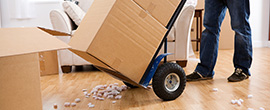The Art and Risk of Moving Pianos: Leave It to Professionals
Posted on 23/05/2025
The Art and Risk of Moving Pianos: Leave It to Professionals
Moving a piano is far more than just shifting an object from point A to point B. It's an intricate blend of science, artistry, and physical strength, where mistakes can prove catastrophic for your instrument, your home, and your health. Understanding the art and risk of moving pianos is crucial, and this is why most musicians and homeowners agree: it's wise to leave the task to experienced professionals.

Understanding the Complexity of Piano Moving
Pianos are not just heavy - they are complex, sensitive, and often irreplaceable. With thousands of moving parts, unique shapes, and delicate finishes, moving a piano without specialized expertise can lead to damage that is costly or even impossible to repair. This section breaks down why piano moving requires a special touch and highlights the unique risks involved.
The Anatomy of a Piano: Why They're So Difficult to Move
- Weight Distribution: Pianos often weigh between 300 to over 1200 pounds, but the weight is not evenly distributed. Grand pianos, for example, are extremely long yet fragile across their width. Uprights have most of their weight concentrated in the upper section.
- Delicate Mechanisms: Inside a piano are over 10,000 individual parts, many highly sensitive. One jolt can cause misalignments, broken strings, or worse - a cracked soundboard.
- Delicate Exterior: Pianos often feature polished wood, delicate veneers, or intricate finishes. Even a minor scrape can spoil the instrument's look and value.
- Irregular Shapes: Unlike a rectangular sofa, a piano's legs, pedals, and casework make it unwieldy to maneuver through doorways and staircases.
Common Types of Pianos and Their Moving Challenges
- Grand Pianos: These can span up to 9 feet in length and require disassembly of legs, pedals, and lids for safe transport. They are heavy, elongated, and extremely cumbersome.
- Upright Pianos: These are compact but tall and top-heavy, making them tricky to move up and down stairs.
- Digital Pianos: While generally lighter, some models still require careful handling to avoid damaging delicate electronics.
The Risks of DIY Piano Moving
Tempted to save money and move your own piano? The risks far outweigh the potential savings. Here's what can go wrong if you attempt a piano move without professional help:
Physical Hazards
- Personal Injury: Lifting and maneuvering hundreds of pounds without proper equipment and technique can easily result in back strains, crushed fingers, or worse.
- Property Damage: Dropping or misdirecting a piano can cause deep scratches, dents, or holes in floors, stairs, and walls.
- Damage to the Instrument: Incorrect handling can snap strings, damage the keyboard, or crack the crucial soundboard.
The Hidden Costs of "Saving Money"
- Insufficient Equipment: Many underestimate the need for specialized dollies, ramps, straps, and padding. Renting this equipment -- if it's even available -- adds unexpected costs.
- Insurance Woes: Most homeowners' insurance doesn't cover damage caused by unprofessional moves. You could be left paying for repairs -- or a replacement -- out of pocket.
- Repair and Tuning Costs: Even slight movements can knock a piano out of tune or warp its frame, requiring expensive professional attention after the move.
The Professional Piano Mover's Advantage
Professional piano moving services offer more than muscle; they bring training, experience, and the right equipment to ensure the safe transport of your valuable instrument. Here's why this specialized service is worth every penny:
Expertise and Experience
- Trained crews know how to disassemble, transport, and reassemble all types of pianos with minimal risk of damage.
- Years of experience teach movers how to strategize for tight corners, staircases, and tricky landscapes.
- Moving grand pianos or baby grands? The process requires careful labeling and packaging of legs, pedals, and lids. One misplaced component can jeopardize the entire instrument.
Specialized Tools and Equipment
- Piano dollies: Custom-built for heavy, awkward loads; these enable smooth transportation across various surfaces.
- Padded blankets and wraps: Protection against bumps and scratches during the move.
- Heavy-duty straps and harnesses: Essential for securing the instrument on stairways, elevators, or inside trucks.
Comprehensive Insurance Coverage
Reliable piano moving companies are insured. If - despite best efforts - an accident occurs, your instrument and property are covered. This peace of mind is something no DIY mover can provide.
How Professional Piano Movers Plan and Execute a Move
So, how do professionals manage this seemingly impossible task? Here's a breakdown of the meticulous process employed by experienced piano movers:
1. Initial Assessment and Planning
- Movers survey the type of piano, the originating and destination sites, and the required route (stairs, elevators, obstacles, etc.).
- They identify potential challenges, such as narrow hallways or steep staircases, and prep accordingly.
2. Disassembly and Preparation
- For grand pianos, movers carefully detach legs and pedals, then wrap all pieces in protective blankets.
- The lid is secured or removed as appropriate; the body is strapped onto a custom dolly.
- Upright and digital pianos are sealed and padded to protect keys, strings, and finishes.
3. Safe Transportation
- Movers use teamwork and communication to navigate the piano through the home.
- Ramps are used for stairs and uneven surfaces; harnesses secure the load for safe truck transport.
- In the vehicle, the piano is tied down and padded to prevent any movement en route.
4. Reassembly and Final Placement
- At the new location, movers carefully reassemble, position, and check the piano.
- If necessary, they can help schedule professional tuning post-move, as even the best moves can necessitate a tune-up.
Factors Affecting the Cost of Piano Moving Services
It's only natural to consider cost when hiring professional piano moving services. While a piano move is an investment, several factors determine the final price:
- Type and Size: Grand pianos usually cost more to move than uprights due to their complexity and weight.
- Distance: Whether relocating locally or across the country, travel distance is a significant cost factor.
- Access Issues: Flights of stairs, narrow doors, or lack of elevator access can increase labor time and risk.
- Additional Services: Disassembly, storage, or complicated setups may incur extra charges.
Remember, the cost of professional moving is minimal compared to the potential price of repairs or replacement if things go awry during a DIY attempt.
Tips for Choosing a Professional Piano Moving Company
Not all movers are created equal. When entrusting your instrument to a service, look for these critical factors:
- Experience: Choose movers with a track record in piano transportation.
- Insurance: Confirm full liability and cargo damage insurance for your peace of mind.
- Specialized Equipment: Ensure the company uses industry-standard tools for piano moves.
- Reputation: Check online reviews and seek recommendations from trusted sources.
- Transparent Pricing: Avoid low-ball quotes that could lead to surprise charges or minimal service.

After the Move: Caring for Your Piano
The job isn't done when your piano reaches its new home. Here's how to ensure your instrument remains in prime condition post-move:
- Allow Acclimatization: Changes in humidity and temperature can affect tuning. Let your piano rest for a couple of weeks before tuning.
- Schedule Professional Tuning: Even with the best care, pianos may go out of tune during a move.
- Check for Damage: Inspect for any visible damage and test each key and pedal to ensure everything functions as it should.
Conclusion: The Smart Choice is Professional Piano Moving
Moving a piano is both an art and a risk. The blend of significant weight, delicate mechanisms, and monetary and sentimental value means that transporting these majestic instruments is a task best left to the experts. Professional piano movers bring skill, equipment, and peace of mind - ensuring your instrument arrives safely, ready to make music again.
Whether you're a concert pianist, music student, or a family cherishing a legacy piano, remember: piano moving is not a DIY project. Attempting it on your own can put both you and your prized instrument in jeopardy. Invest wisely in trusted professionals to protect your investment and enjoy your piano for generations to come.










